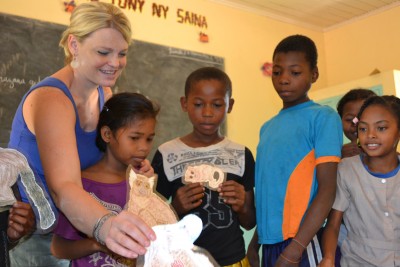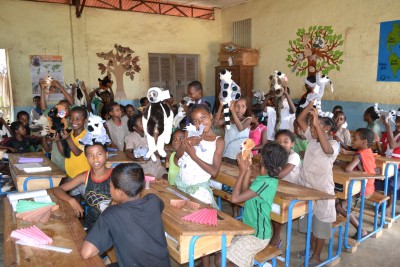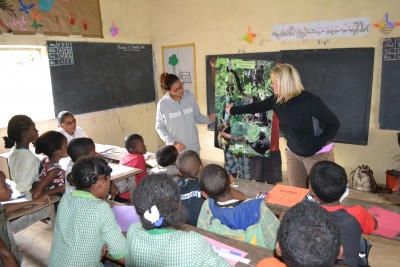How did you get started working with lemurs and conservation in Madagascar?
Since I was a little girl, I have always had a passion for animals, the environment, and wanting to make a difference. I worked at the Omaha Zoo for 13 years and it was during that time that I had the opportunity to work with lemurs in captivity as a zookeeper.
Then, I transferred to the Conservation and Research center where I worked with lemur DNA and mentored Malagasy students in the molecular genetics laboratory. In this laboratory, new species were discovered and our population assessments and biodiversity and biogeography projects provided so much novel information about the island of Madagascar.
I was so excited about the diversity of Madagascar, but was concerned about how we could ensure it would remain for future generations. This experience helped me to realize the need for coexistence between people and animals. I strongly believe education is a key component to conservation.
After 13 years working at the Omaha Zoo, why did you decide to start your own organization?
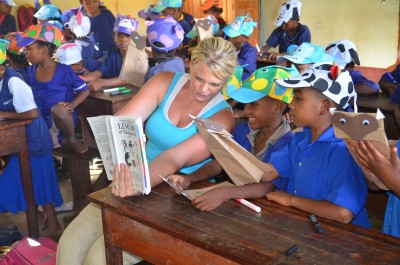
Following the trip, I was compelled to make a difference. With two-thirds of Madagascar’s population under the age of 20, I realized this created a unique opportunity to educate and influence the future conservation leaders: the children!
So, I worked on drawing pages for a 200 page conservation-based coloring & activity book entitled Lemurs: Your National Treasure. In 2007, the books, along with crayons and notebooks, were distributed to 15,000 Malagasy primary school children living in areas inhabited by five of the most endangered lemur species.
This book was a reflection of my desire to use education to initiate positive change. Following the books’ distribution, lemur hunting significantly decreased in these areas.
Did the success of this book lead you to take the leap to start Conservation Fusion?
Yes. After seeing the success of this book, I worked to spearhead education programs including the funding, development and implementation of a novel conservation education program in Kianjavato, Madagascar in 2009.
I felt so strongly about education that I left my zoo career to launch an educational non-profit, Conservation Fusion, to engage kids and communities in education to learn about biodiversity and become responsible stewards for a sustainable future.
Can you explain the mission and goals of Conservation Fusion?
Conservation Fusion aims to provide educational programs to create an awareness and understanding of the world’s unique biodiversity and instill ownership while empowering kids to take responsible action for their future.
Another goal is to connect children in the USA with kids in Madagascar providing a unique opportunity for kids to explore new cultures and conservation endeavors because what happens there affects us here.
Have your efforts with Conservation Fusion in Madagascar proven successful?
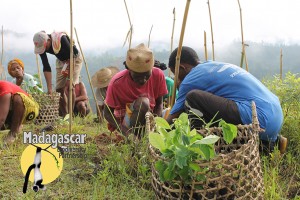
After five years of on the ground efforts, we are seeing some positive behavior changes within the communities we are dedicated and committed to.
Lemur populations are on the rise and people are beginning to understand how conservation can be a win-win for people, animals and the environment. People are beginning to understand and take pride in rebuilding lemur habitat.
They are receiving tangible benefits for conservation by serving as lemur guides, planting trees and working for local NGOs like the Madagascar Biodiversity Partnership.
What projects are you currently working on at Conservation Fusion?
Our current focus is a kind of a dirty subject as we are focusing on the compost used for Reforestation efforts and community and school gardens! It may seem like this is not related to saving lemurs at all, but we need to establish this foundation as we work towards our ultimate goal of protecting lemurs and their environment.
People need food, lemurs need forests, and both people and lemurs need good soil and compost!
The composting project will really move the Kianjavato community forward in their efforts to improve farming techniques and continue with the reforestation efforts. The community is currently planting close to 25,000 trees/month to provide for the community and simultaneously rebuild lemur habitat!
What is a typical day like for you?

I enjoy this so much and work to get students, educators and people from diverse backgrounds involved in the process. It helps raise awareness and I believe it’s all connected.
The choices we make in our daily lives impact what is happening in the world’s biodiversity hotspots, like Madagascar, and we all have the power to make a difference.
What is your day like when you’re working in the field?
In the field, it is non-stop…and I love it! We spend a lot of time in the car. Roads in Madagascar are not like the USA! There are many hours on bumpy, dirt roads with many giant holes! A lot of villages where we work are rural and take literally days to reach. One site in the south even requires us to drive the car onto a ferry and the Mozambique channel to reach our final destination! On site, we sleep in tents and cook with and eat with the local villagers. We spend time meeting with local leaders, teachers and a great deal of time in the classroom!
You mentioned how important partnerships and collaboration are for conservation in Madagascar. Can you give us more information about some of your partnerships?
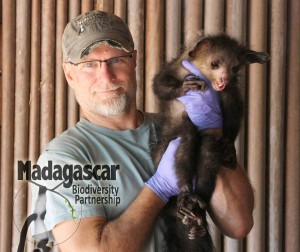
One of the greatest strengths of our education programs is partnership, and we are lucky to work with Dr. Ed Louis and the Madagascar Biodiversity Partnership team. They are the island’s lemur experts and focus a lot on lemur monitoring, research and community development. We always make sure to connect with them and take local children into the forest with their help!
For many kids, it is the first time they see lemurs in their native habitat, and learn more about how they live. Connecting kids and teachers with nature inspires them and they become compassionate about taking action to ensure lemurs are around for generations to come.
What are some challenges for conservation work in Madagascar?
The toughest part is that there are never enough hours in the day to tackle all of the challenges of lemur conservation. Let’s face it: it’s absolutely not just about the lemurs!
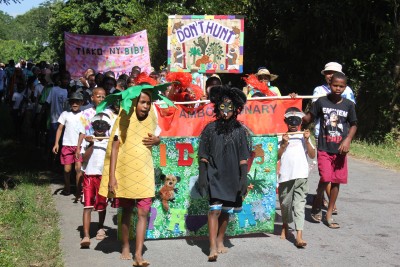
We spend a great deal of time talking to local people (who live with lemurs and are the experts) and really, really listening to what they have to say. Next, we incorporate their needs and establish an action plan to create coexistence between people, lemurs and the environment.
What are your long-term goals for Conservation Fusion?
In ten years, I imagine visiting the sites where we work and seeing the conservation programs managed by local people who have participated in our education programs. I envision a forest – where there was once nothing – now with growing lemur populations and eco-tourism. This future that I envision is already starting to happen, but it takes a lot of rolling up the sleeves, hard work, building relationships, and patience.
Today, we are creating a sense of pride, based upon a true understanding of the forest ecosystem where people, animals and the environment can coexist and the local people are running the projects and programs themselves.
How can people across the world help save lemurs and support your work?
Learn about lemurs and share what you learn! Get involved! Every little bit makes a difference; a little can go a long way in Madagascar.
All organizations need money to function an you can definitely donate funds, but you can also help raise those funds in creative, meaningful ways. For example, you can organize a bake sale with Malagasy themed treats, host a read-a-thon featured books about Madagascar, or even organize a Skype presentation with a research or conservation organization to learn what they are doing and how you can help.
Donations can support on-the-ground conservation organizations in Madagascar who can report back to you how your dollars made a difference! Then, share that, keep the momentum going, and you will see what you can achieve!
Take Action
- Want to support Susie’s work at Conservation Fusion? Learn more about Conservation Fusion!
- Conservation Fusion often works closely with the Madagascar Biodiversity Partnership, which could also use your support!
Lynne Venart contributed to this post.

